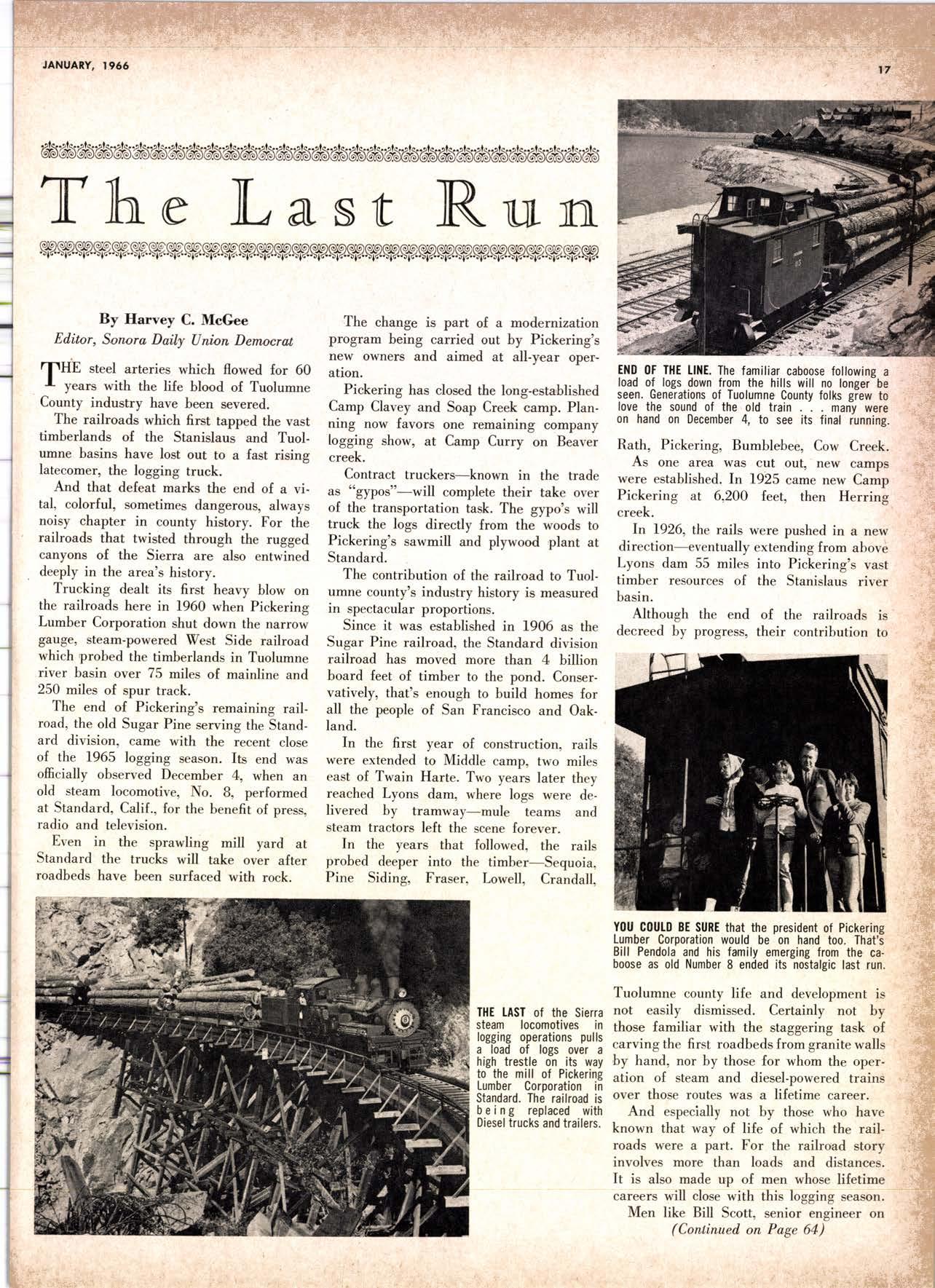
2 minute read
T][l.e Last Rulrn
By Harvey C. McGee Ed,itor, Sarwra Daily Unbn Democrat
THE steel arteries which flowed for 60 r years with the life blood of Tuolumne County industry have been severed.
The railroads which first tapped the vast timberlands of the Stanislaus and Tuolumne basins have lost out to a fast risine latecomer, the logging truck.
And that defeat marks the end of a vital, colorful, sometimes dangerous, always noisy chapter in county history. For the railroads that twisted through the rugged canyons of the Sierra are also entwined deeply in the area's history.
Trucking dealt its first heavy blow on the railroads here in 1960 when Pickerine Lumber Corporation shut down the narrori gauge, steam-powered West Side railroad which probed the timberlands in Tuolumne river basin over 75 miles of mainline and 250 miles of spur track.
The end of Pickering's remaining railroad, the old Sugar Pine serving the Standard division, came with the iecent close of the 1965 logging season. Its end was officially observed December 4, when an old steam locomotive, No. 8, performed at Standard, Calif., for the benefit of press, radio and television.
Even in the sprawling mill yard at Standard the trucks will take over after roadbeds have been surfaced with rock.
The change is part of a modernization program being carried out by Pickering's new owners and aimed at all-year operation.
Pickering has closed the long-established Camp Clavey and Soap Creek camp. Planning now favors one remaining company logging show, at Camp Curry on Beaver creek.
Contract truckers-known in the trade &s oogypos"-will complete their take over of the transportation task. The gypo's will truck the logs directly from the woods to Pickering's sawmill and plywood plant at Standard.
The contribution of the railroad to Tuolumne county's industry history is measured in spectacular proportions.
Since it was established in 1906 as the Sugar Pine railroad, the Standard division railroad has moved more than 4 billion board feet of timber to the pond. Conservatively, that's enough to build homes for all the people of San Francisco and Oakland.
In the first year of construction, rails were extended to Middle camp, two miles east of Twain Harte. Two vears later thev reached Lyons dam, where logs wer" d"livered by tramway-mule team. and steam tractors left the scene forever.
In the years that followed, the rails probed deeper into the timber-Sequoia, Pine Siding, Fraser, Lowell, Crandall,
Rath, Pickering, Bumblebee, Cow Creek.
As one area was cut out, new camps were established. In 1925 came new Camp Pickering at 6,200 feet, then Herring creek.
In 1926, the rails were pushed in a new direction-eventually extending from above Lyons dam 55 miles into Pickering's vast timber resources of the Stanislaus river basin.
Although the end of the railroads is decreed by progress, their contribution to
Tuolumne county life and development is not easily dismissed. Certainly not by those familiar with the staggering task of carving the first roadbeds from granite walls by hand, nor by those lor whom the operation of steam and diesel-powered trains over those routes was a lifetime career.
And especially not by those who have known that way of life of which the railroads were a part. For the railroad story involves more than loads and distances. It is also made up of men whose lifetime careers will close with this logging season.
Men like Bill Scott, senior ensineer on (Continued on Page 64)
UOMPACT AND EFFICIENT living is provided in this modest dwelling while versatile planning is apparent throughout the design.
As we have pointed out many times in the past, the smaller the home, the more important storage space becomes. Many financial agencies only require a bedroom closet of three feet in width. The three bedrooms here have a total of twenty-five {eet of wardrobe !
The living room is very spacious, con' sidering that the entire house is less than lI00 square feet in size. This attribute will be appreciated more as time goes by. The










